Examining Unemployment in Australia: Trends, Impact, and Challenges
VerifiedAdded on 2023/06/11
|15
|3327
|313
Essay
AI Summary
This essay examines the trends in unemployment in Australia over the past five years, identifying specific causes and focusing on particular groups such as youth and immigrants. It discusses the types of unemployment, including cyclical, structural, and frictional, and their impact on the Australian labor market. The analysis covers the period from 2013 to 2018, highlighting fluctuations in unemployment rates and labor force participation. The essay also addresses the challenges faced by vulnerable groups, such as the long-term unemployment issues among youth and the difficulties faced by migrants, particularly those from North Africa and the Middle East. Furthermore, it explores the adverse effects of unemployment on economic and social well-being, including the erosion of skills and increased social issues. The essay concludes by discussing the employment challenges in Australia, such as demographic dynamics, long-term unemployment, and the slower pace of job creation after the global financial crisis. Desklib provides this essay along with numerous other resources to assist students in their academic pursuits.
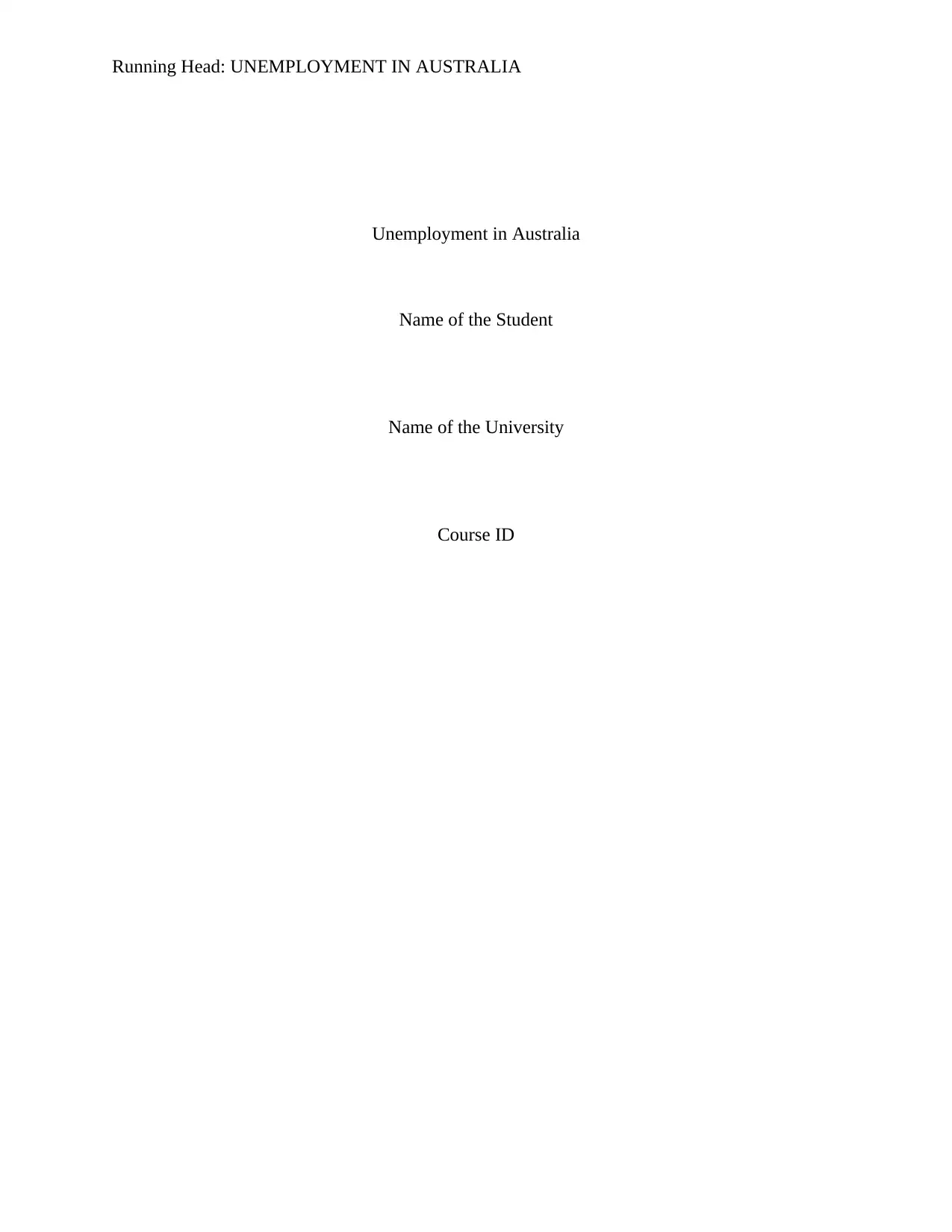
Running Head: UNEMPLOYMENT IN AUSTRALIA
Unemployment in Australia
Name of the Student
Name of the University
Course ID
Unemployment in Australia
Name of the Student
Name of the University
Course ID
Paraphrase This Document
Need a fresh take? Get an instant paraphrase of this document with our AI Paraphraser
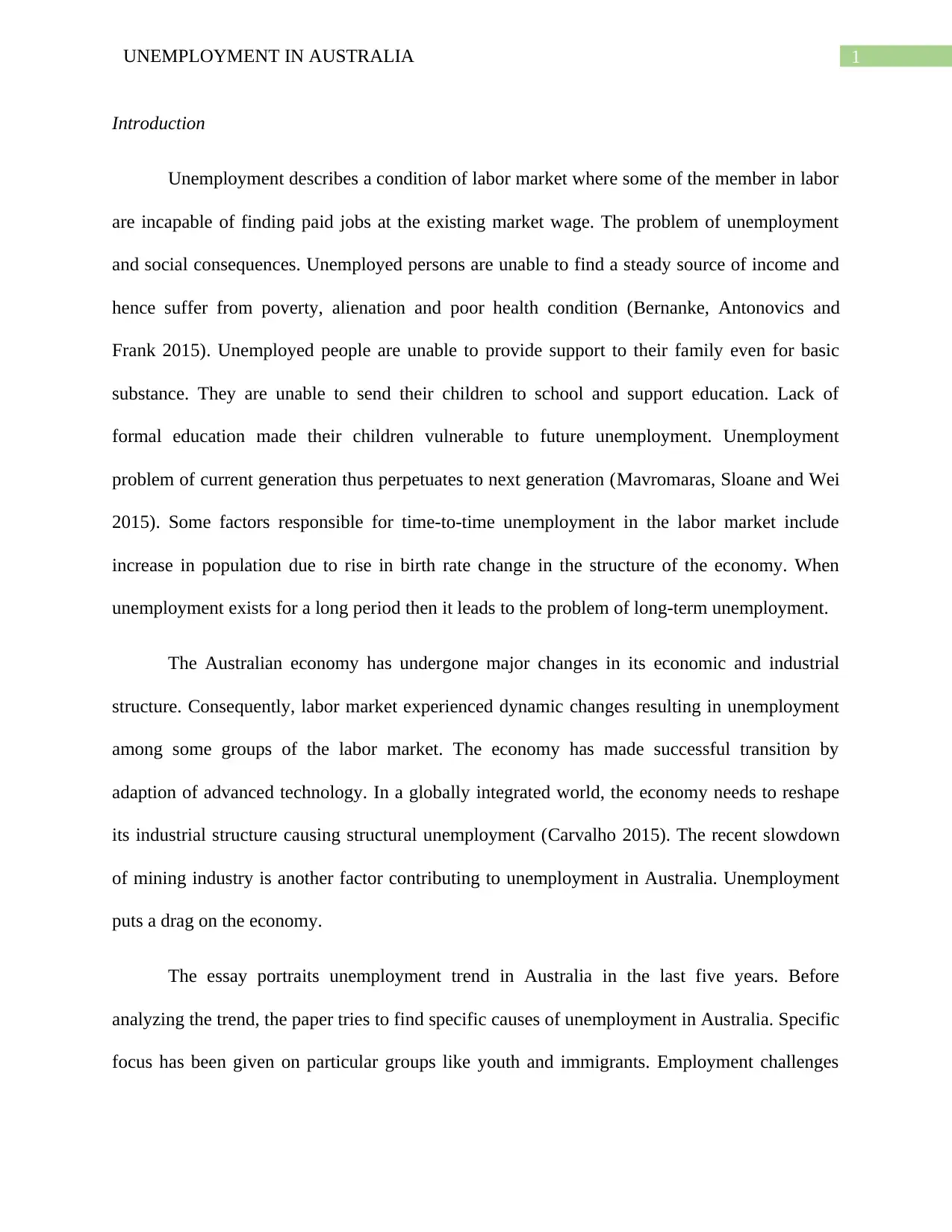
1UNEMPLOYMENT IN AUSTRALIA
Introduction
Unemployment describes a condition of labor market where some of the member in labor
are incapable of finding paid jobs at the existing market wage. The problem of unemployment
and social consequences. Unemployed persons are unable to find a steady source of income and
hence suffer from poverty, alienation and poor health condition (Bernanke, Antonovics and
Frank 2015). Unemployed people are unable to provide support to their family even for basic
substance. They are unable to send their children to school and support education. Lack of
formal education made their children vulnerable to future unemployment. Unemployment
problem of current generation thus perpetuates to next generation (Mavromaras, Sloane and Wei
2015). Some factors responsible for time-to-time unemployment in the labor market include
increase in population due to rise in birth rate change in the structure of the economy. When
unemployment exists for a long period then it leads to the problem of long-term unemployment.
The Australian economy has undergone major changes in its economic and industrial
structure. Consequently, labor market experienced dynamic changes resulting in unemployment
among some groups of the labor market. The economy has made successful transition by
adaption of advanced technology. In a globally integrated world, the economy needs to reshape
its industrial structure causing structural unemployment (Carvalho 2015). The recent slowdown
of mining industry is another factor contributing to unemployment in Australia. Unemployment
puts a drag on the economy.
The essay portraits unemployment trend in Australia in the last five years. Before
analyzing the trend, the paper tries to find specific causes of unemployment in Australia. Specific
focus has been given on particular groups like youth and immigrants. Employment challenges
Introduction
Unemployment describes a condition of labor market where some of the member in labor
are incapable of finding paid jobs at the existing market wage. The problem of unemployment
and social consequences. Unemployed persons are unable to find a steady source of income and
hence suffer from poverty, alienation and poor health condition (Bernanke, Antonovics and
Frank 2015). Unemployed people are unable to provide support to their family even for basic
substance. They are unable to send their children to school and support education. Lack of
formal education made their children vulnerable to future unemployment. Unemployment
problem of current generation thus perpetuates to next generation (Mavromaras, Sloane and Wei
2015). Some factors responsible for time-to-time unemployment in the labor market include
increase in population due to rise in birth rate change in the structure of the economy. When
unemployment exists for a long period then it leads to the problem of long-term unemployment.
The Australian economy has undergone major changes in its economic and industrial
structure. Consequently, labor market experienced dynamic changes resulting in unemployment
among some groups of the labor market. The economy has made successful transition by
adaption of advanced technology. In a globally integrated world, the economy needs to reshape
its industrial structure causing structural unemployment (Carvalho 2015). The recent slowdown
of mining industry is another factor contributing to unemployment in Australia. Unemployment
puts a drag on the economy.
The essay portraits unemployment trend in Australia in the last five years. Before
analyzing the trend, the paper tries to find specific causes of unemployment in Australia. Specific
focus has been given on particular groups like youth and immigrants. Employment challenges

2UNEMPLOYMENT IN AUSTRALIA
are considered along with remedial measures taken by the Australian government to combat
unemployment.
Types and causes of unemployment
Unemployment in an economy caused by a number of different factors. There can
cyclical and structural factors that lead to steady unemployment in an economy. Cyclical,
structural and frictional are the three main forms of unemployment. The different forms of
unemployment provide useful insight to understand the existing unemployment problem in an
economy. Cyclical unemployment is the form of unemployment caused during recessionary
phases of business cycle or economic cycle. The economic downturn during recession causes a
shortage of demand for goods and services leads to a lack of jobs. The weaker demand condition
in the goods market reduces labor demand aggravating the unemployment problem. Australia
experienced cyclical unemployment during recession of 1990s and global financial crisis of 2008
(Bachmann and Sinning 2016). Labor market suffers with the problem of structural
unemployment when skills of laborers do not match with the requirement of available jobs. In
the manufacturing sector, advanced automation technique resulted in a considerable job loss
among manual laborers. Unemployment resulted from structural factors tend to sustain for a
longer period as it usually takes time for workers to develop required skills. Long-standing
structural unemployment in Australia causes steady long-term unemployment in the economy.
Frictional unemployment indicates unemployment exists during transition between two jobs.
Apart from unemployment, one prominent problem of Australian labor market is
underemployment (Li, Duncan and Miranti 2015). Underemployment describes a scenario when
people though engaged in paid jobs but less than hours, they are willing to. Underemployment is
are considered along with remedial measures taken by the Australian government to combat
unemployment.
Types and causes of unemployment
Unemployment in an economy caused by a number of different factors. There can
cyclical and structural factors that lead to steady unemployment in an economy. Cyclical,
structural and frictional are the three main forms of unemployment. The different forms of
unemployment provide useful insight to understand the existing unemployment problem in an
economy. Cyclical unemployment is the form of unemployment caused during recessionary
phases of business cycle or economic cycle. The economic downturn during recession causes a
shortage of demand for goods and services leads to a lack of jobs. The weaker demand condition
in the goods market reduces labor demand aggravating the unemployment problem. Australia
experienced cyclical unemployment during recession of 1990s and global financial crisis of 2008
(Bachmann and Sinning 2016). Labor market suffers with the problem of structural
unemployment when skills of laborers do not match with the requirement of available jobs. In
the manufacturing sector, advanced automation technique resulted in a considerable job loss
among manual laborers. Unemployment resulted from structural factors tend to sustain for a
longer period as it usually takes time for workers to develop required skills. Long-standing
structural unemployment in Australia causes steady long-term unemployment in the economy.
Frictional unemployment indicates unemployment exists during transition between two jobs.
Apart from unemployment, one prominent problem of Australian labor market is
underemployment (Li, Duncan and Miranti 2015). Underemployment describes a scenario when
people though engaged in paid jobs but less than hours, they are willing to. Underemployment is
⊘ This is a preview!⊘
Do you want full access?
Subscribe today to unlock all pages.

Trusted by 1+ million students worldwide

3UNEMPLOYMENT IN AUSTRALIA
reflected from part time employment statistics. Groups vulnerable to underemployment are
mostly youth, older and female participants.
reflected from part time employment statistics. Groups vulnerable to underemployment are
mostly youth, older and female participants.
Paraphrase This Document
Need a fresh take? Get an instant paraphrase of this document with our AI Paraphraser
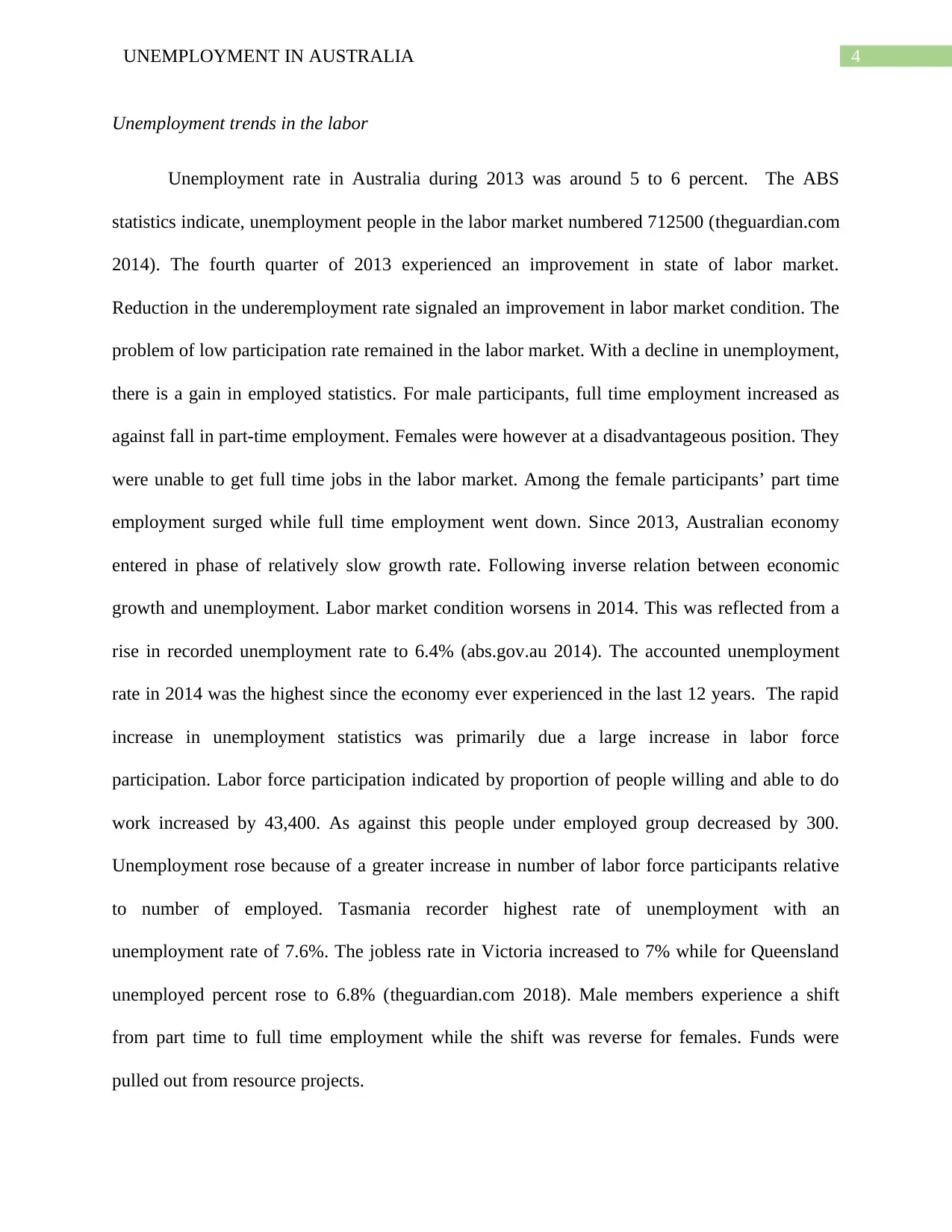
4UNEMPLOYMENT IN AUSTRALIA
Unemployment trends in the labor
Unemployment rate in Australia during 2013 was around 5 to 6 percent. The ABS
statistics indicate, unemployment people in the labor market numbered 712500 (theguardian.com
2014). The fourth quarter of 2013 experienced an improvement in state of labor market.
Reduction in the underemployment rate signaled an improvement in labor market condition. The
problem of low participation rate remained in the labor market. With a decline in unemployment,
there is a gain in employed statistics. For male participants, full time employment increased as
against fall in part-time employment. Females were however at a disadvantageous position. They
were unable to get full time jobs in the labor market. Among the female participants’ part time
employment surged while full time employment went down. Since 2013, Australian economy
entered in phase of relatively slow growth rate. Following inverse relation between economic
growth and unemployment. Labor market condition worsens in 2014. This was reflected from a
rise in recorded unemployment rate to 6.4% (abs.gov.au 2014). The accounted unemployment
rate in 2014 was the highest since the economy ever experienced in the last 12 years. The rapid
increase in unemployment statistics was primarily due a large increase in labor force
participation. Labor force participation indicated by proportion of people willing and able to do
work increased by 43,400. As against this people under employed group decreased by 300.
Unemployment rose because of a greater increase in number of labor force participants relative
to number of employed. Tasmania recorder highest rate of unemployment with an
unemployment rate of 7.6%. The jobless rate in Victoria increased to 7% while for Queensland
unemployed percent rose to 6.8% (theguardian.com 2018). Male members experience a shift
from part time to full time employment while the shift was reverse for females. Funds were
pulled out from resource projects.
Unemployment trends in the labor
Unemployment rate in Australia during 2013 was around 5 to 6 percent. The ABS
statistics indicate, unemployment people in the labor market numbered 712500 (theguardian.com
2014). The fourth quarter of 2013 experienced an improvement in state of labor market.
Reduction in the underemployment rate signaled an improvement in labor market condition. The
problem of low participation rate remained in the labor market. With a decline in unemployment,
there is a gain in employed statistics. For male participants, full time employment increased as
against fall in part-time employment. Females were however at a disadvantageous position. They
were unable to get full time jobs in the labor market. Among the female participants’ part time
employment surged while full time employment went down. Since 2013, Australian economy
entered in phase of relatively slow growth rate. Following inverse relation between economic
growth and unemployment. Labor market condition worsens in 2014. This was reflected from a
rise in recorded unemployment rate to 6.4% (abs.gov.au 2014). The accounted unemployment
rate in 2014 was the highest since the economy ever experienced in the last 12 years. The rapid
increase in unemployment statistics was primarily due a large increase in labor force
participation. Labor force participation indicated by proportion of people willing and able to do
work increased by 43,400. As against this people under employed group decreased by 300.
Unemployment rose because of a greater increase in number of labor force participants relative
to number of employed. Tasmania recorder highest rate of unemployment with an
unemployment rate of 7.6%. The jobless rate in Victoria increased to 7% while for Queensland
unemployed percent rose to 6.8% (theguardian.com 2018). Male members experience a shift
from part time to full time employment while the shift was reverse for females. Funds were
pulled out from resource projects.
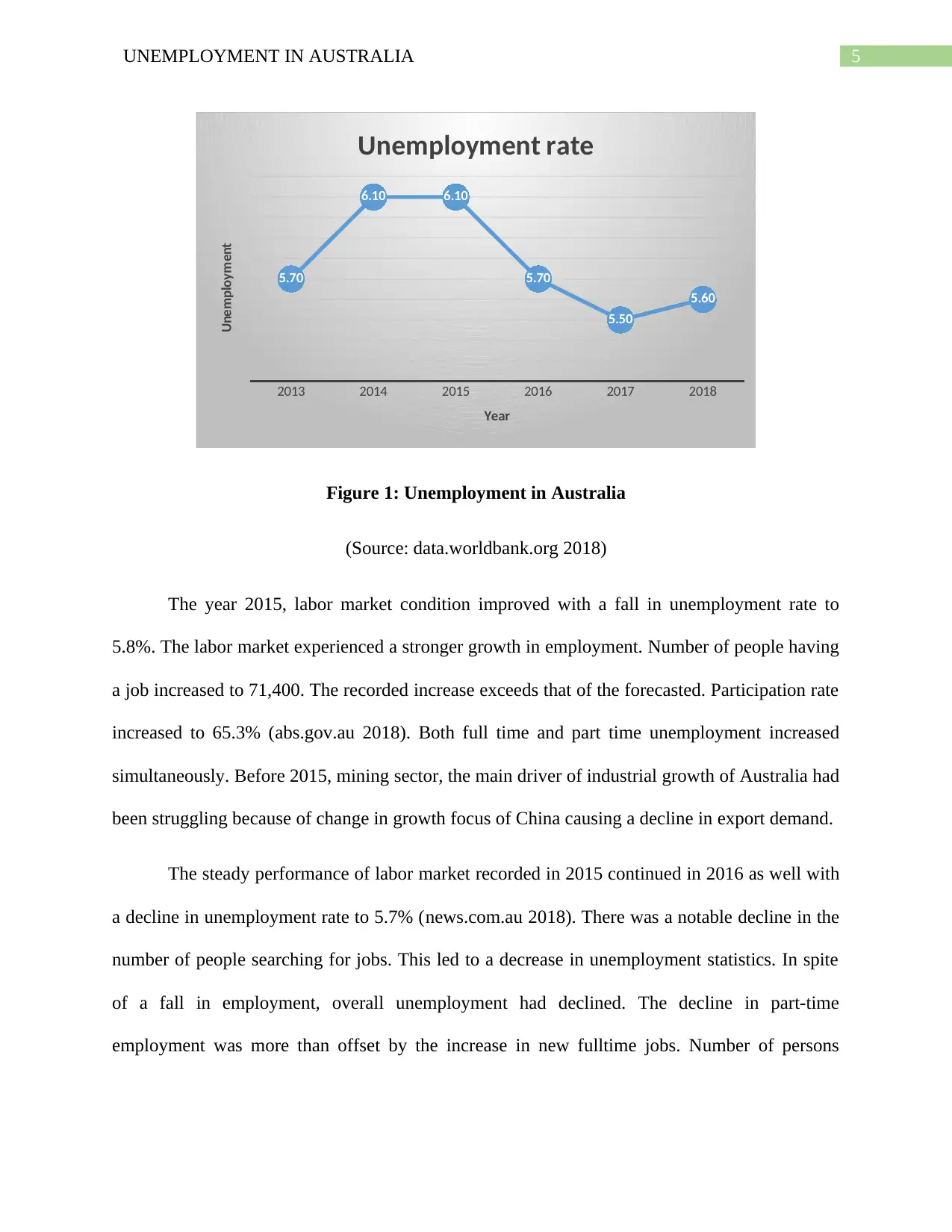
5UNEMPLOYMENT IN AUSTRALIA
2013 2014 2015 2016 2017 2018
5.70
6.10 6.10
5.70
5.50
5.60
Unemployment rate
Year
Unemployment
Figure 1: Unemployment in Australia
(Source: data.worldbank.org 2018)
The year 2015, labor market condition improved with a fall in unemployment rate to
5.8%. The labor market experienced a stronger growth in employment. Number of people having
a job increased to 71,400. The recorded increase exceeds that of the forecasted. Participation rate
increased to 65.3% (abs.gov.au 2018). Both full time and part time unemployment increased
simultaneously. Before 2015, mining sector, the main driver of industrial growth of Australia had
been struggling because of change in growth focus of China causing a decline in export demand.
The steady performance of labor market recorded in 2015 continued in 2016 as well with
a decline in unemployment rate to 5.7% (news.com.au 2018). There was a notable decline in the
number of people searching for jobs. This led to a decrease in unemployment statistics. In spite
of a fall in employment, overall unemployment had declined. The decline in part-time
employment was more than offset by the increase in new fulltime jobs. Number of persons
2013 2014 2015 2016 2017 2018
5.70
6.10 6.10
5.70
5.50
5.60
Unemployment rate
Year
Unemployment
Figure 1: Unemployment in Australia
(Source: data.worldbank.org 2018)
The year 2015, labor market condition improved with a fall in unemployment rate to
5.8%. The labor market experienced a stronger growth in employment. Number of people having
a job increased to 71,400. The recorded increase exceeds that of the forecasted. Participation rate
increased to 65.3% (abs.gov.au 2018). Both full time and part time unemployment increased
simultaneously. Before 2015, mining sector, the main driver of industrial growth of Australia had
been struggling because of change in growth focus of China causing a decline in export demand.
The steady performance of labor market recorded in 2015 continued in 2016 as well with
a decline in unemployment rate to 5.7% (news.com.au 2018). There was a notable decline in the
number of people searching for jobs. This led to a decrease in unemployment statistics. In spite
of a fall in employment, overall unemployment had declined. The decline in part-time
employment was more than offset by the increase in new fulltime jobs. Number of persons
⊘ This is a preview!⊘
Do you want full access?
Subscribe today to unlock all pages.

Trusted by 1+ million students worldwide
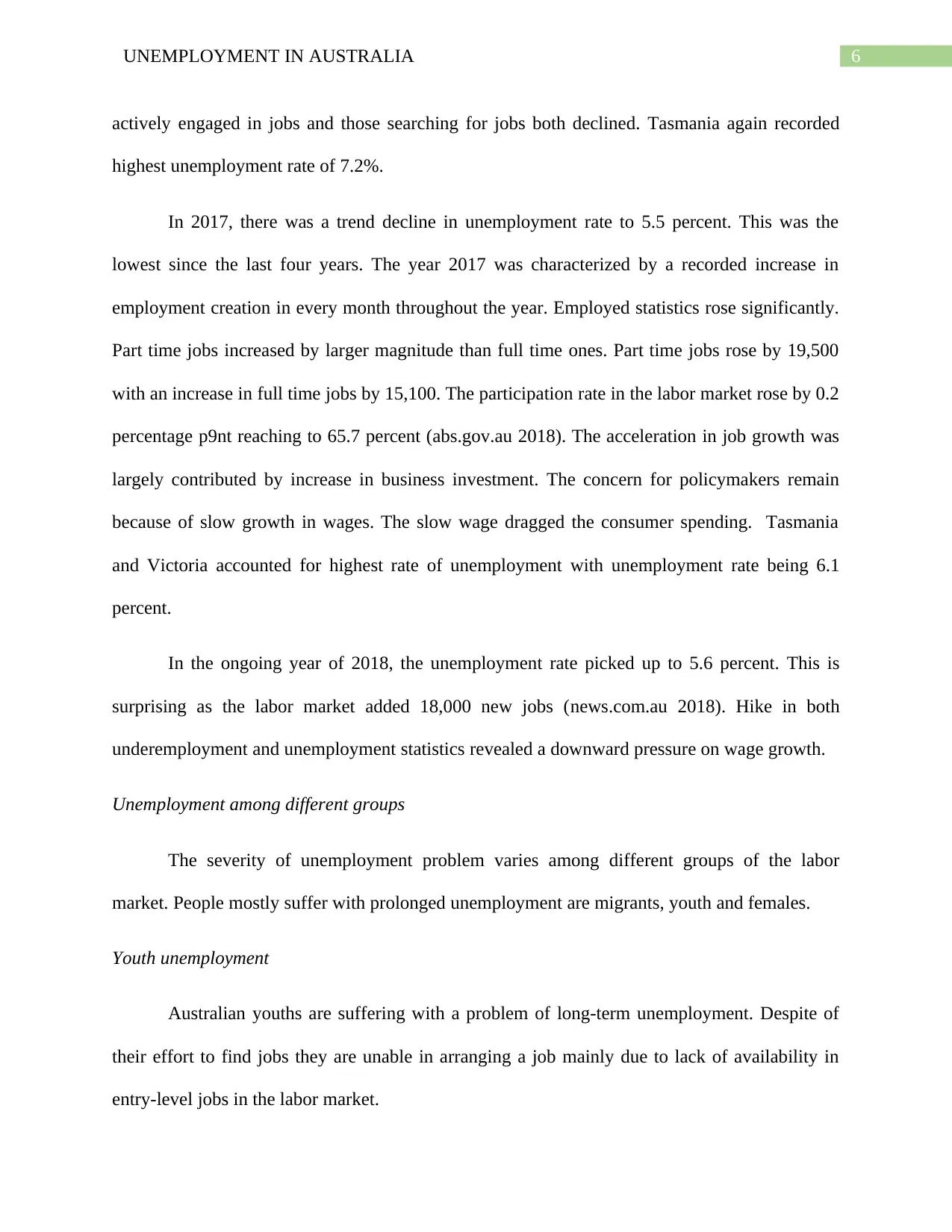
6UNEMPLOYMENT IN AUSTRALIA
actively engaged in jobs and those searching for jobs both declined. Tasmania again recorded
highest unemployment rate of 7.2%.
In 2017, there was a trend decline in unemployment rate to 5.5 percent. This was the
lowest since the last four years. The year 2017 was characterized by a recorded increase in
employment creation in every month throughout the year. Employed statistics rose significantly.
Part time jobs increased by larger magnitude than full time ones. Part time jobs rose by 19,500
with an increase in full time jobs by 15,100. The participation rate in the labor market rose by 0.2
percentage p9nt reaching to 65.7 percent (abs.gov.au 2018). The acceleration in job growth was
largely contributed by increase in business investment. The concern for policymakers remain
because of slow growth in wages. The slow wage dragged the consumer spending. Tasmania
and Victoria accounted for highest rate of unemployment with unemployment rate being 6.1
percent.
In the ongoing year of 2018, the unemployment rate picked up to 5.6 percent. This is
surprising as the labor market added 18,000 new jobs (news.com.au 2018). Hike in both
underemployment and unemployment statistics revealed a downward pressure on wage growth.
Unemployment among different groups
The severity of unemployment problem varies among different groups of the labor
market. People mostly suffer with prolonged unemployment are migrants, youth and females.
Youth unemployment
Australian youths are suffering with a problem of long-term unemployment. Despite of
their effort to find jobs they are unable in arranging a job mainly due to lack of availability in
entry-level jobs in the labor market.
actively engaged in jobs and those searching for jobs both declined. Tasmania again recorded
highest unemployment rate of 7.2%.
In 2017, there was a trend decline in unemployment rate to 5.5 percent. This was the
lowest since the last four years. The year 2017 was characterized by a recorded increase in
employment creation in every month throughout the year. Employed statistics rose significantly.
Part time jobs increased by larger magnitude than full time ones. Part time jobs rose by 19,500
with an increase in full time jobs by 15,100. The participation rate in the labor market rose by 0.2
percentage p9nt reaching to 65.7 percent (abs.gov.au 2018). The acceleration in job growth was
largely contributed by increase in business investment. The concern for policymakers remain
because of slow growth in wages. The slow wage dragged the consumer spending. Tasmania
and Victoria accounted for highest rate of unemployment with unemployment rate being 6.1
percent.
In the ongoing year of 2018, the unemployment rate picked up to 5.6 percent. This is
surprising as the labor market added 18,000 new jobs (news.com.au 2018). Hike in both
underemployment and unemployment statistics revealed a downward pressure on wage growth.
Unemployment among different groups
The severity of unemployment problem varies among different groups of the labor
market. People mostly suffer with prolonged unemployment are migrants, youth and females.
Youth unemployment
Australian youths are suffering with a problem of long-term unemployment. Despite of
their effort to find jobs they are unable in arranging a job mainly due to lack of availability in
entry-level jobs in the labor market.
Paraphrase This Document
Need a fresh take? Get an instant paraphrase of this document with our AI Paraphraser
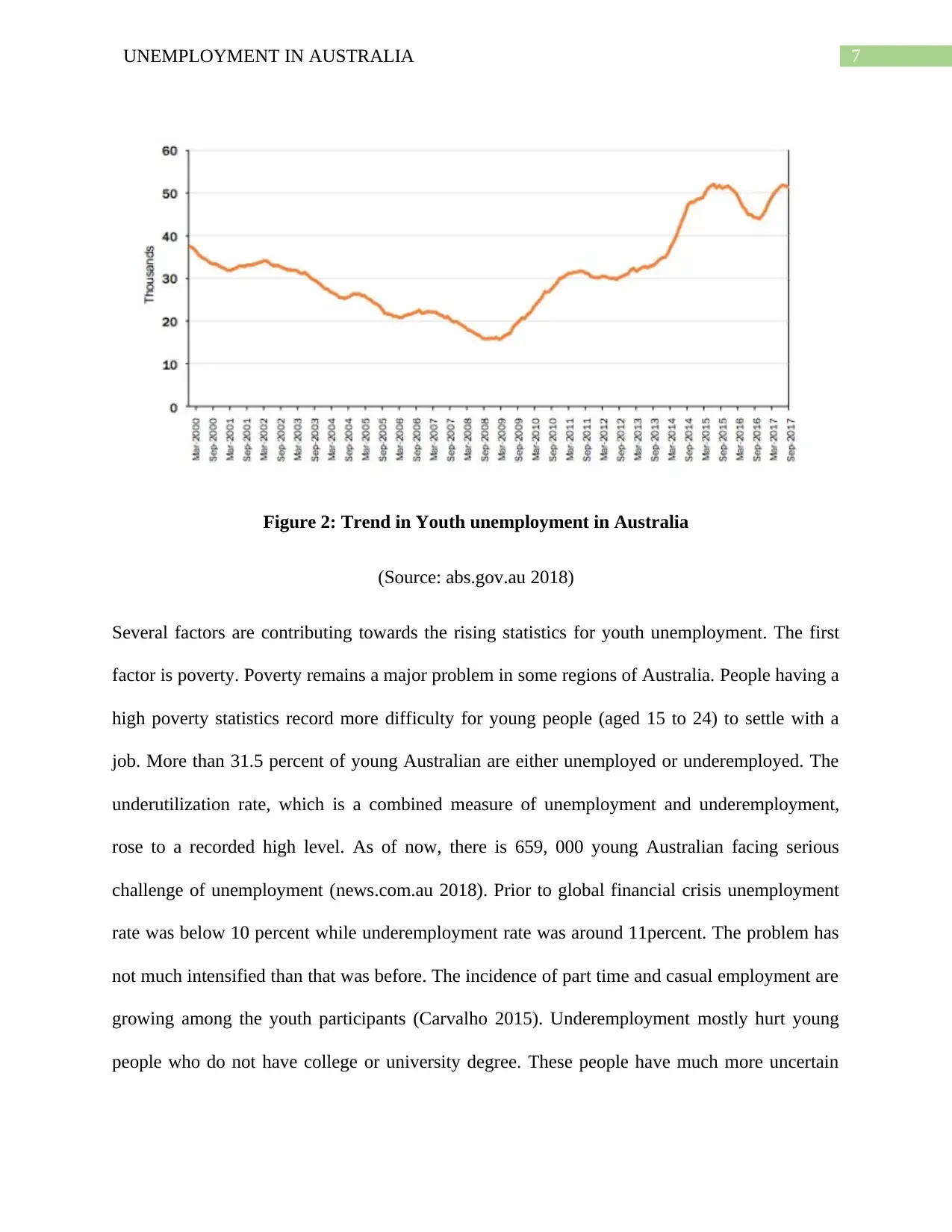
7UNEMPLOYMENT IN AUSTRALIA
Figure 2: Trend in Youth unemployment in Australia
(Source: abs.gov.au 2018)
Several factors are contributing towards the rising statistics for youth unemployment. The first
factor is poverty. Poverty remains a major problem in some regions of Australia. People having a
high poverty statistics record more difficulty for young people (aged 15 to 24) to settle with a
job. More than 31.5 percent of young Australian are either unemployed or underemployed. The
underutilization rate, which is a combined measure of unemployment and underemployment,
rose to a recorded high level. As of now, there is 659, 000 young Australian facing serious
challenge of unemployment (news.com.au 2018). Prior to global financial crisis unemployment
rate was below 10 percent while underemployment rate was around 11percent. The problem has
not much intensified than that was before. The incidence of part time and casual employment are
growing among the youth participants (Carvalho 2015). Underemployment mostly hurt young
people who do not have college or university degree. These people have much more uncertain
Figure 2: Trend in Youth unemployment in Australia
(Source: abs.gov.au 2018)
Several factors are contributing towards the rising statistics for youth unemployment. The first
factor is poverty. Poverty remains a major problem in some regions of Australia. People having a
high poverty statistics record more difficulty for young people (aged 15 to 24) to settle with a
job. More than 31.5 percent of young Australian are either unemployed or underemployed. The
underutilization rate, which is a combined measure of unemployment and underemployment,
rose to a recorded high level. As of now, there is 659, 000 young Australian facing serious
challenge of unemployment (news.com.au 2018). Prior to global financial crisis unemployment
rate was below 10 percent while underemployment rate was around 11percent. The problem has
not much intensified than that was before. The incidence of part time and casual employment are
growing among the youth participants (Carvalho 2015). Underemployment mostly hurt young
people who do not have college or university degree. These people have much more uncertain
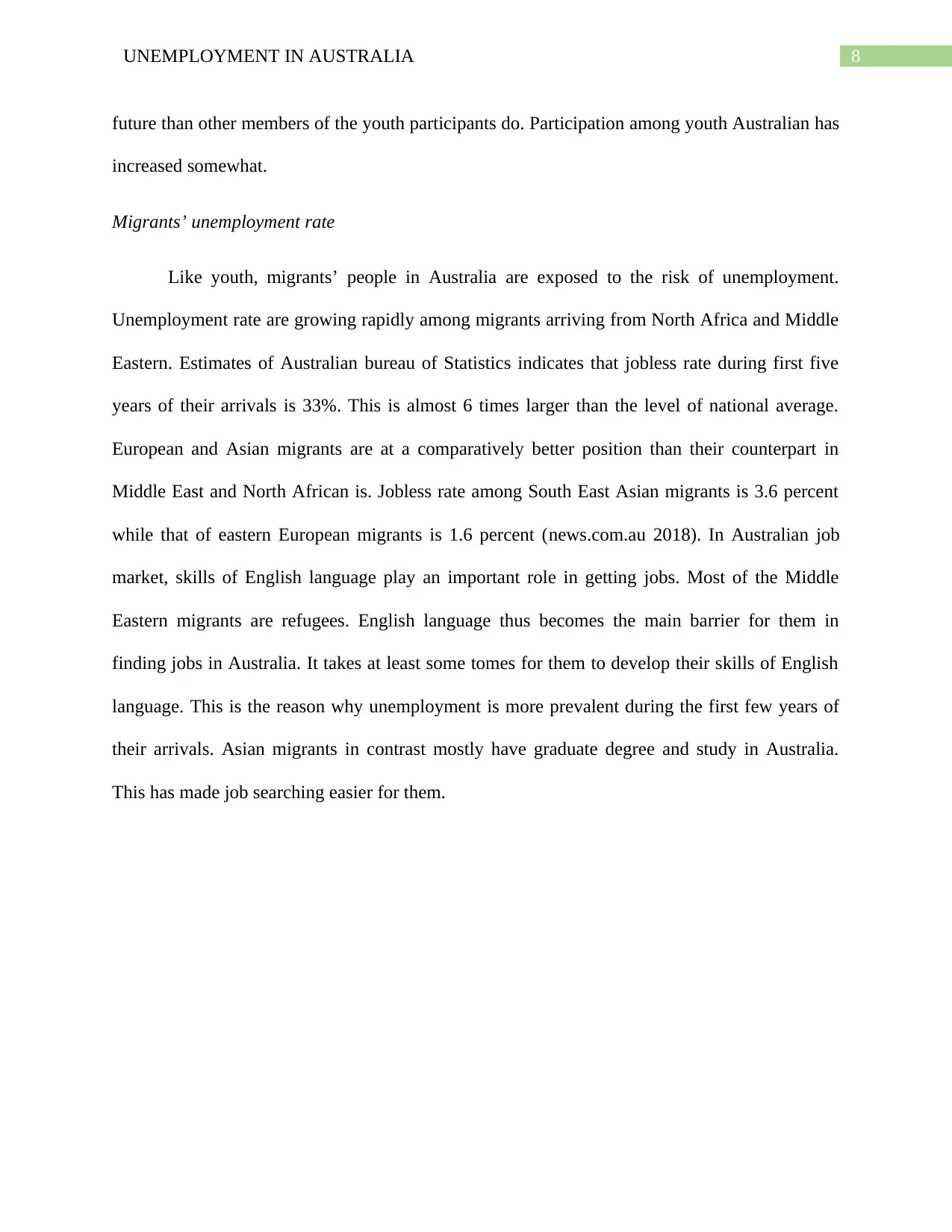
8UNEMPLOYMENT IN AUSTRALIA
future than other members of the youth participants do. Participation among youth Australian has
increased somewhat.
Migrants’ unemployment rate
Like youth, migrants’ people in Australia are exposed to the risk of unemployment.
Unemployment rate are growing rapidly among migrants arriving from North Africa and Middle
Eastern. Estimates of Australian bureau of Statistics indicates that jobless rate during first five
years of their arrivals is 33%. This is almost 6 times larger than the level of national average.
European and Asian migrants are at a comparatively better position than their counterpart in
Middle East and North African is. Jobless rate among South East Asian migrants is 3.6 percent
while that of eastern European migrants is 1.6 percent (news.com.au 2018). In Australian job
market, skills of English language play an important role in getting jobs. Most of the Middle
Eastern migrants are refugees. English language thus becomes the main barrier for them in
finding jobs in Australia. It takes at least some tomes for them to develop their skills of English
language. This is the reason why unemployment is more prevalent during the first few years of
their arrivals. Asian migrants in contrast mostly have graduate degree and study in Australia.
This has made job searching easier for them.
future than other members of the youth participants do. Participation among youth Australian has
increased somewhat.
Migrants’ unemployment rate
Like youth, migrants’ people in Australia are exposed to the risk of unemployment.
Unemployment rate are growing rapidly among migrants arriving from North Africa and Middle
Eastern. Estimates of Australian bureau of Statistics indicates that jobless rate during first five
years of their arrivals is 33%. This is almost 6 times larger than the level of national average.
European and Asian migrants are at a comparatively better position than their counterpart in
Middle East and North African is. Jobless rate among South East Asian migrants is 3.6 percent
while that of eastern European migrants is 1.6 percent (news.com.au 2018). In Australian job
market, skills of English language play an important role in getting jobs. Most of the Middle
Eastern migrants are refugees. English language thus becomes the main barrier for them in
finding jobs in Australia. It takes at least some tomes for them to develop their skills of English
language. This is the reason why unemployment is more prevalent during the first few years of
their arrivals. Asian migrants in contrast mostly have graduate degree and study in Australia.
This has made job searching easier for them.
⊘ This is a preview!⊘
Do you want full access?
Subscribe today to unlock all pages.

Trusted by 1+ million students worldwide
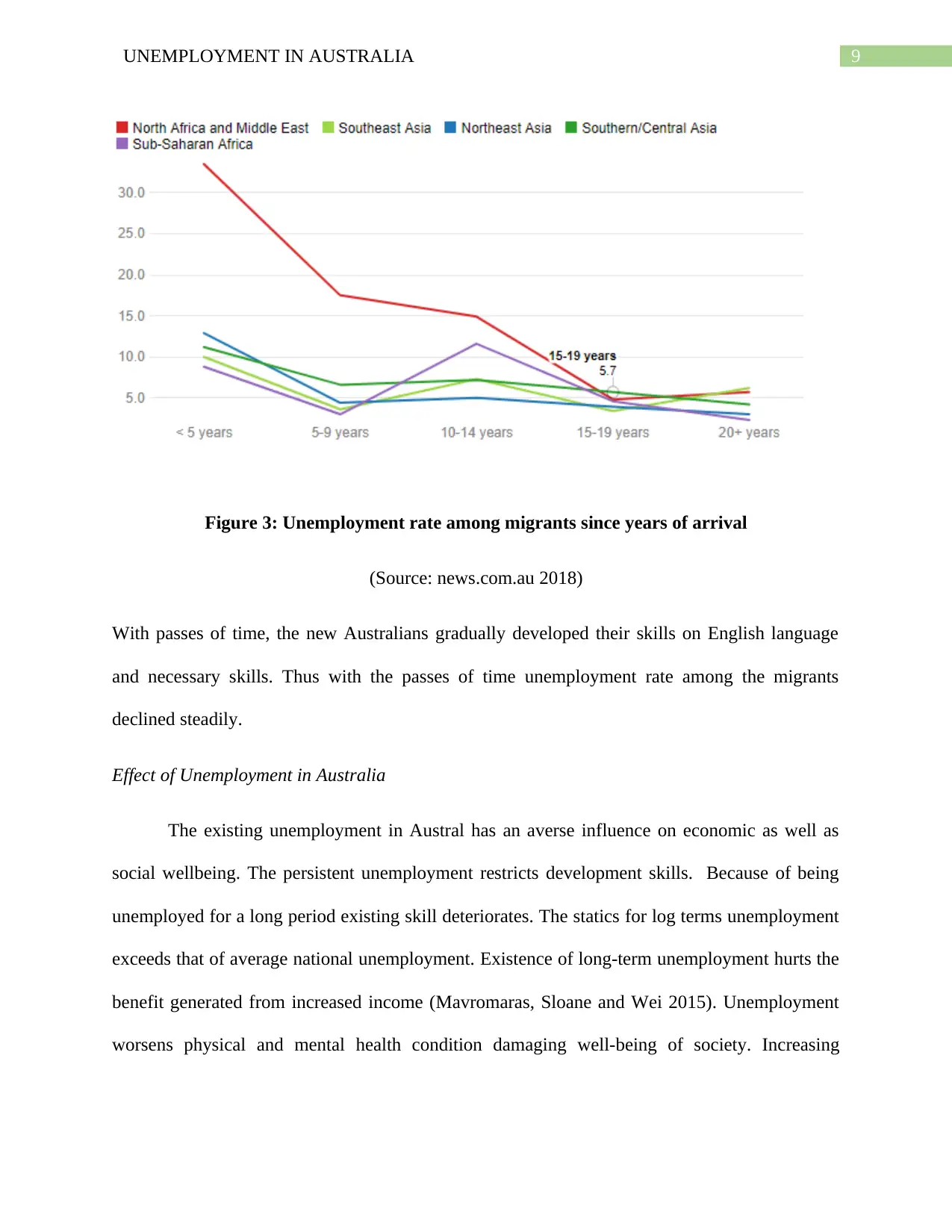
9UNEMPLOYMENT IN AUSTRALIA
Figure 3: Unemployment rate among migrants since years of arrival
(Source: news.com.au 2018)
With passes of time, the new Australians gradually developed their skills on English language
and necessary skills. Thus with the passes of time unemployment rate among the migrants
declined steadily.
Effect of Unemployment in Australia
The existing unemployment in Austral has an averse influence on economic as well as
social wellbeing. The persistent unemployment restricts development skills. Because of being
unemployed for a long period existing skill deteriorates. The statics for log terms unemployment
exceeds that of average national unemployment. Existence of long-term unemployment hurts the
benefit generated from increased income (Mavromaras, Sloane and Wei 2015). Unemployment
worsens physical and mental health condition damaging well-being of society. Increasing
Figure 3: Unemployment rate among migrants since years of arrival
(Source: news.com.au 2018)
With passes of time, the new Australians gradually developed their skills on English language
and necessary skills. Thus with the passes of time unemployment rate among the migrants
declined steadily.
Effect of Unemployment in Australia
The existing unemployment in Austral has an averse influence on economic as well as
social wellbeing. The persistent unemployment restricts development skills. Because of being
unemployed for a long period existing skill deteriorates. The statics for log terms unemployment
exceeds that of average national unemployment. Existence of long-term unemployment hurts the
benefit generated from increased income (Mavromaras, Sloane and Wei 2015). Unemployment
worsens physical and mental health condition damaging well-being of society. Increasing
Paraphrase This Document
Need a fresh take? Get an instant paraphrase of this document with our AI Paraphraser
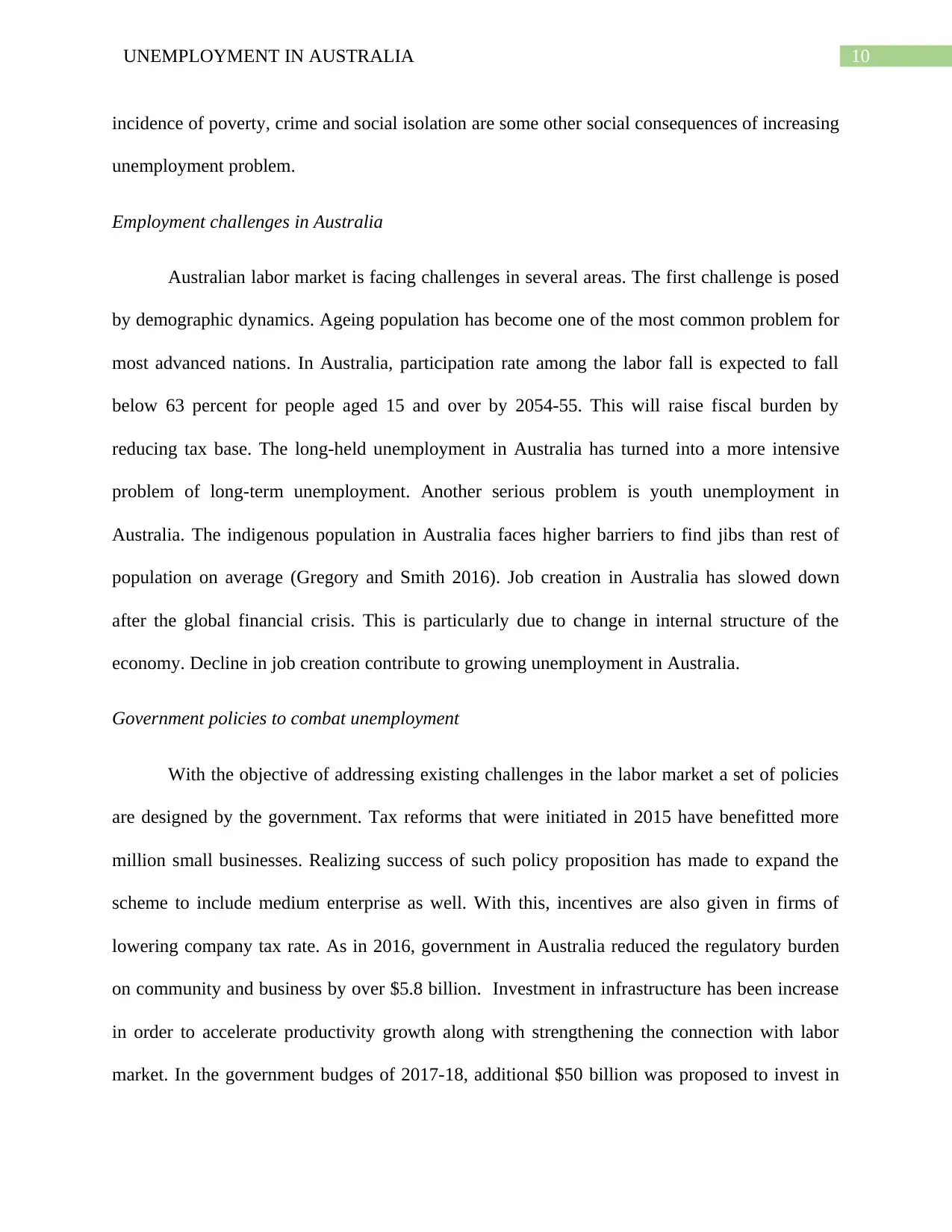
10UNEMPLOYMENT IN AUSTRALIA
incidence of poverty, crime and social isolation are some other social consequences of increasing
unemployment problem.
Employment challenges in Australia
Australian labor market is facing challenges in several areas. The first challenge is posed
by demographic dynamics. Ageing population has become one of the most common problem for
most advanced nations. In Australia, participation rate among the labor fall is expected to fall
below 63 percent for people aged 15 and over by 2054-55. This will raise fiscal burden by
reducing tax base. The long-held unemployment in Australia has turned into a more intensive
problem of long-term unemployment. Another serious problem is youth unemployment in
Australia. The indigenous population in Australia faces higher barriers to find jibs than rest of
population on average (Gregory and Smith 2016). Job creation in Australia has slowed down
after the global financial crisis. This is particularly due to change in internal structure of the
economy. Decline in job creation contribute to growing unemployment in Australia.
Government policies to combat unemployment
With the objective of addressing existing challenges in the labor market a set of policies
are designed by the government. Tax reforms that were initiated in 2015 have benefitted more
million small businesses. Realizing success of such policy proposition has made to expand the
scheme to include medium enterprise as well. With this, incentives are also given in firms of
lowering company tax rate. As in 2016, government in Australia reduced the regulatory burden
on community and business by over $5.8 billion. Investment in infrastructure has been increase
in order to accelerate productivity growth along with strengthening the connection with labor
market. In the government budges of 2017-18, additional $50 billion was proposed to invest in
incidence of poverty, crime and social isolation are some other social consequences of increasing
unemployment problem.
Employment challenges in Australia
Australian labor market is facing challenges in several areas. The first challenge is posed
by demographic dynamics. Ageing population has become one of the most common problem for
most advanced nations. In Australia, participation rate among the labor fall is expected to fall
below 63 percent for people aged 15 and over by 2054-55. This will raise fiscal burden by
reducing tax base. The long-held unemployment in Australia has turned into a more intensive
problem of long-term unemployment. Another serious problem is youth unemployment in
Australia. The indigenous population in Australia faces higher barriers to find jibs than rest of
population on average (Gregory and Smith 2016). Job creation in Australia has slowed down
after the global financial crisis. This is particularly due to change in internal structure of the
economy. Decline in job creation contribute to growing unemployment in Australia.
Government policies to combat unemployment
With the objective of addressing existing challenges in the labor market a set of policies
are designed by the government. Tax reforms that were initiated in 2015 have benefitted more
million small businesses. Realizing success of such policy proposition has made to expand the
scheme to include medium enterprise as well. With this, incentives are also given in firms of
lowering company tax rate. As in 2016, government in Australia reduced the regulatory burden
on community and business by over $5.8 billion. Investment in infrastructure has been increase
in order to accelerate productivity growth along with strengthening the connection with labor
market. In the government budges of 2017-18, additional $50 billion was proposed to invest in
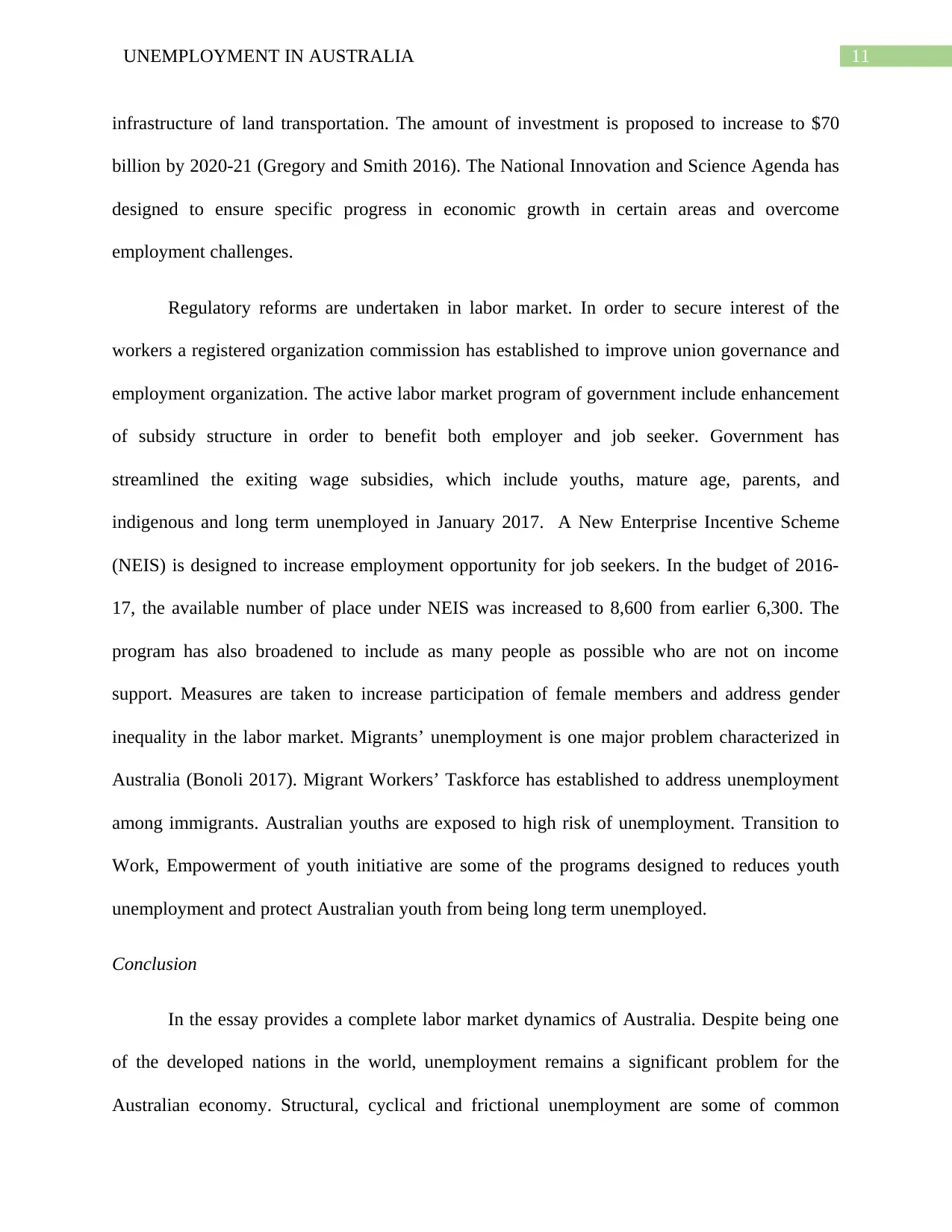
11UNEMPLOYMENT IN AUSTRALIA
infrastructure of land transportation. The amount of investment is proposed to increase to $70
billion by 2020-21 (Gregory and Smith 2016). The National Innovation and Science Agenda has
designed to ensure specific progress in economic growth in certain areas and overcome
employment challenges.
Regulatory reforms are undertaken in labor market. In order to secure interest of the
workers a registered organization commission has established to improve union governance and
employment organization. The active labor market program of government include enhancement
of subsidy structure in order to benefit both employer and job seeker. Government has
streamlined the exiting wage subsidies, which include youths, mature age, parents, and
indigenous and long term unemployed in January 2017. A New Enterprise Incentive Scheme
(NEIS) is designed to increase employment opportunity for job seekers. In the budget of 2016-
17, the available number of place under NEIS was increased to 8,600 from earlier 6,300. The
program has also broadened to include as many people as possible who are not on income
support. Measures are taken to increase participation of female members and address gender
inequality in the labor market. Migrants’ unemployment is one major problem characterized in
Australia (Bonoli 2017). Migrant Workers’ Taskforce has established to address unemployment
among immigrants. Australian youths are exposed to high risk of unemployment. Transition to
Work, Empowerment of youth initiative are some of the programs designed to reduces youth
unemployment and protect Australian youth from being long term unemployed.
Conclusion
In the essay provides a complete labor market dynamics of Australia. Despite being one
of the developed nations in the world, unemployment remains a significant problem for the
Australian economy. Structural, cyclical and frictional unemployment are some of common
infrastructure of land transportation. The amount of investment is proposed to increase to $70
billion by 2020-21 (Gregory and Smith 2016). The National Innovation and Science Agenda has
designed to ensure specific progress in economic growth in certain areas and overcome
employment challenges.
Regulatory reforms are undertaken in labor market. In order to secure interest of the
workers a registered organization commission has established to improve union governance and
employment organization. The active labor market program of government include enhancement
of subsidy structure in order to benefit both employer and job seeker. Government has
streamlined the exiting wage subsidies, which include youths, mature age, parents, and
indigenous and long term unemployed in January 2017. A New Enterprise Incentive Scheme
(NEIS) is designed to increase employment opportunity for job seekers. In the budget of 2016-
17, the available number of place under NEIS was increased to 8,600 from earlier 6,300. The
program has also broadened to include as many people as possible who are not on income
support. Measures are taken to increase participation of female members and address gender
inequality in the labor market. Migrants’ unemployment is one major problem characterized in
Australia (Bonoli 2017). Migrant Workers’ Taskforce has established to address unemployment
among immigrants. Australian youths are exposed to high risk of unemployment. Transition to
Work, Empowerment of youth initiative are some of the programs designed to reduces youth
unemployment and protect Australian youth from being long term unemployed.
Conclusion
In the essay provides a complete labor market dynamics of Australia. Despite being one
of the developed nations in the world, unemployment remains a significant problem for the
Australian economy. Structural, cyclical and frictional unemployment are some of common
⊘ This is a preview!⊘
Do you want full access?
Subscribe today to unlock all pages.

Trusted by 1+ million students worldwide
1 out of 15
Related Documents
Your All-in-One AI-Powered Toolkit for Academic Success.
+13062052269
info@desklib.com
Available 24*7 on WhatsApp / Email
![[object Object]](/_next/static/media/star-bottom.7253800d.svg)
Unlock your academic potential
Copyright © 2020–2025 A2Z Services. All Rights Reserved. Developed and managed by ZUCOL.





